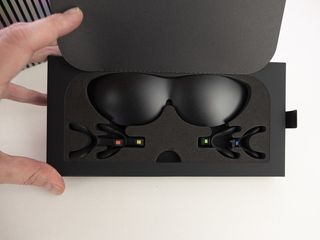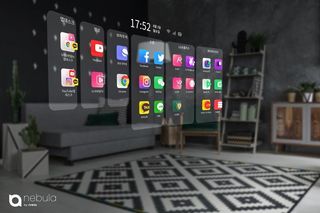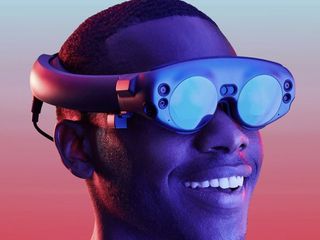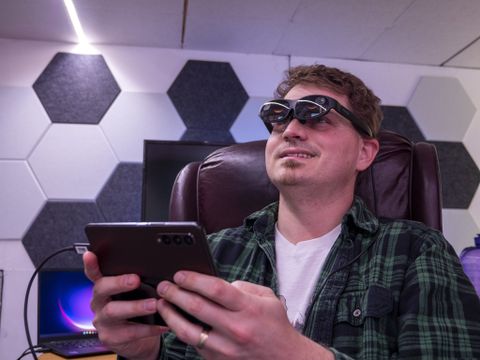Android Central Verdict
Bottom line: Nreal Light represents the best vision of consumer-ready AR glasses that are actually affordable, but even with the significant hardware improvements over the competition, it's software that still hasn't evolved enough for most folks. Still, if you're an AR enthusiast, Nreal Light offers a compelling experience that you'll likely enjoy.
Pros
- +
Lighter and smaller than the competition
- +
More affordable than ever
- +
A quality virtual display
- +
Surprisingly wide field of view
- +
Easy setup
Cons
- -
Limited compatibility with hardware and apps
- -
Still expensive for a mainstream product
- -
Mixed-reality experience needs work
- -
Still not comfortable enough for hours of use
Why you can trust Android Central
It's been nearly two years since we first got our hands on Nreal Light and, at the time, Nreal seemed like it was finally ready to deliver a consumer AR product that people might actually care about. Considering it's hundreds or even thousands less than the competition and Nreal Light is available at Verizon stores, all the pieces are in place for success.
After all, the premise is pretty exciting. Put on a pair of Nreal Light glasses, plug the USB Type-C cable into your phone, and you suddenly have a choice between turning your phone's screen into a giant 220-inch virtual projection — that only you can see, of course — or working via a fully-tracked mixed reality virtual desktop with floating windows and the whole nine yards.
Since they're AR glasses, not VR like an Oculus Quest 2, you can see right through the lenses to the world around you.
It sounds like something from the pages of science fiction and, indeed, much of it feels just within reach. But too many parts of the experience regularly brought me back to actual reality — one that isn't augmented by cutting-edge technology — and made me painfully aware that someone who spends $599 on a pair of these AR glasses is almost assuredly going to be disappointed.
Nreal Light: Price and availability

Nreal Light went on sale in the U.S. on November 18, 2021 in select Verizon stores throughout the country. The glasses were later made available online on December 2 on Verizon's website and on Nreal's website. Nreal Light glasses retail for $599.
Since then, Nreal Light has sold out at Verizon and is on backorder although, at the time of publishing for this review, you could still order them on Nreal's website.
Nreal Light glasses come with a pair of glasses with non-removable cable, four different sized nose pads, a small clip to aid in cable management while wearing the glasses, a lens frame for using prescription lenses with Nreal Light, a VR cover, manual, and cleaning cloth.
Nreal Light: A more refined product

If you've ever used a pair of AR glasses, you'll know that most of them are bulky monstrosities. Nreal Light, on the other hand, is almost as tidy as a pair of "smart glasses" like Ray-Ban Stories. They weigh 106 grams, which is about 3x heavier than a pair of normal Ray-Bans but still don't feel terribly bulky while wearing.
This hardware is so much sleeker than other AR glasses.
A cable comes out of the back of the left temple, which is used to connect to your smartphone or PC via a USB Type-C connection. This is necessary since Nreal Light glasses have no compute module inside and cannot be operated by themselves.

The lenses themselves are quite good for AR glasses, although they still exhibit the restrictions of current early AR glasses technology. Part of what makes them better than most glasses in this category is the relatively wide 52-degree field of view. That translates into a roughly 220-inch display right in front of your face.
The content displayed on Nreal Light can either be exactly what's happening on your phone's screen or a mixed-reality mode that features floating windows and special AR apps. Both of these modes require the Nreal Nebula app to be installed.








You can also plug them into a Windows-based PC and get a virtual 220-inch monitor, but I didn't have much luck with this feature during my review.
Display quality was surprisingly good, offering up faithful color reproduction and high resolution — roughly 1080p quality — despite being a projection onto the lenses themselves. Nreal is using a unique dome-shaped lens to project the image, which results in a wider, clearer virtual display.
I also found it to be surprisingly bright considering that you can see straight through the virtual display into the world beyond. That is, of course, what makes these AR — that's augmented reality — and not VR, although an included black cover can be snapped onto the outside of the glasses to turn them into VR glasses of sorts.

Nreal Light sports excellent 6DoF tracking, which means you can move your head around naturally and the virtual imagery will stay in place in virtual space exactly as you would expect. Two cameras on the front can track the real world and help a realistic sense of presence for projected virtual information, but they won't be tracking your hands Minority Report style anytime soon.
For me, the best use of these glasses was playing Minecraft with my son while he played on his Nintendo Switch. This gave me a significantly larger display than even my Galaxy Z Fold 3 has, all while enjoying the freedom of holding a controller in my lap as if I were playing on a TV.
I loved playing Minecraft on these, as it was much more comfortable than holding up my phone the whole time.
It's much, much more comfortable than using a game controller that plugs into your phone, as you won't need to hold the phone up the entire time you're playing.
Similarly, you can watch movies or videos while lying down thanks to the ability to reposition the virtual display anywhere you want easily. During the MR mode, you can even use your smartphone as a mouse-like trackpad to point and click around the interface.
Nreal Light: Software really holds it back

If you were hoping for some mind-blowing AR experiences to be had while using Nreal Light, you're going to be sorely disappointed. Nreal shipped me the pair of glasses alongside a OnePlus 9, which was preloaded with several AR experiences. While all of them were pretty cool in a novel way, none of them offered an experience that I would be willing to pay very much for.
Very few apps offer any kind of actual AR experience.
The company's marketing makes the virtual mixed-reality display look quite good and, with a supported app, you can get some truly impressive results. The problem is that there aren't many supported apps right now and, without a supported phone, using any app you have installed in the AR interface isn't an easy or obvious task.
When plugging in the included OnePlus 9 — which was preloaded and pre-configured to give me the best experience — I was able to pull up installed apps and use them in floating windows. That was really cool, and it gave me some great ideas of how I'd like to use the glasses.

But when using my unlocked Galaxy Z Fold 3, I could only use a handful of apps installed on the phone, and it wasn't obvious how to add any more to the list that was shown.
I also thought maybe I could work from the glasses for a day, plugging them into my Lenovo Carbon X1 with Windows 11 installed. Despite it appearing as a secondary 1080p screen, I couldn't get anything to appear on the glasses, and my hopes of having a giant virtual monitor to work from were dashed. Even if i had gotten it working, the cable is a bit too short for this purpose, anyway.
Even when I was using the display to play Minecraft or watch a movie, I had trouble seeing the entire thing. There's no "sweet spot" like you would find with VR lenses, but while everything was perfectly in focus, not everything fit within the lenses. Resizing the virtual window is only possible when in MR mode — which I wasn't using here — and none of the included nose pieces felt like they quite fit right on my face anyway.
I'm still not convinced that I would enjoy wearing these for hours at a time on a regular basis.
I also am not convinced that I would enjoy wearing these for hours at a time. The temples are fairly thick and pushed my ears down a bit, the weight put on my nose was at least mildly uncomfortable all the time, and even the speakers were pretty lackluster.
Nreal Light: Competition

The AR glasses market is still pretty small and, in reality, there isn't much competition for Nreal at the moment. These are the sleekest glasses in their category and, at $600, the most affordable, as well.
If you just want the virtual display functionality, the HTC Vive Flow will offer a better, clearer, and more enveloped view of the virtual world around you. Since Vive Flow is a pair of VR glasses — not AR ones — you won't be able to see the world around you while using them. Movement and interaction are just as limited as Nreal Light's, though, as you'll be using a tethered phone to control the experience — although the Vive Flow has its own included processor and battery.
Beyond that, the only other real choices are significantly more expensive solutions like Microsoft HoloLens or Magic Leap glasses, which sell in upwards of $3,000 for some configurations. On the other side of the spectrum, less expensive glasses like Ray-Ban Stories or Amazon Echo Frames will only cost $200-300 but don't have augmented displays; just a pair of speakers built-in or a camera to take photos and video of the world around you.
Nreal Light: Should you buy it?

You should buy this if ...
- You're an AR developer and want to make unique experiences.
- You are interested in using them as a virtual display for your phone.
- You're a gadget collector.
You shouldn't buy this if...
- You were hoping for revolutionary AR glasses.
- You wanted to use these for working from multiple virtual monitors.
- You want the best portable virtual display solution.
Nreal Light has had a lot of hype for good reason. They're smaller, lighter, and less expensive than basically anything in this product segment. They offer as wide a field of view as much more expensive AR glasses and also can mirror your phone or act as a second monitor for your PC.
3 out of 5
And while the hardware itself could use a few more tweaks to be truly comfortable, the software itself is what really holds the experience back. Sure, it's dependent on your phone to run the experience but, even with a compatible device, you're going to be held back by a lack of app support for true AR experiences and an inconsistent interface between available apps. AR enthusiasts will likely be quite happy with the product, but this is not the mainstream-ready set of glasses I was personally hoping for.

Nreal Light
Bottom line: Nreal Light is the best example yet of a pair of AR glasses that deliver a solid augmented reality experience. Mirroring your phone is nigh perfect, and even some MR apps are cool, but limited app support means these are best as a giant, private virtual display.

